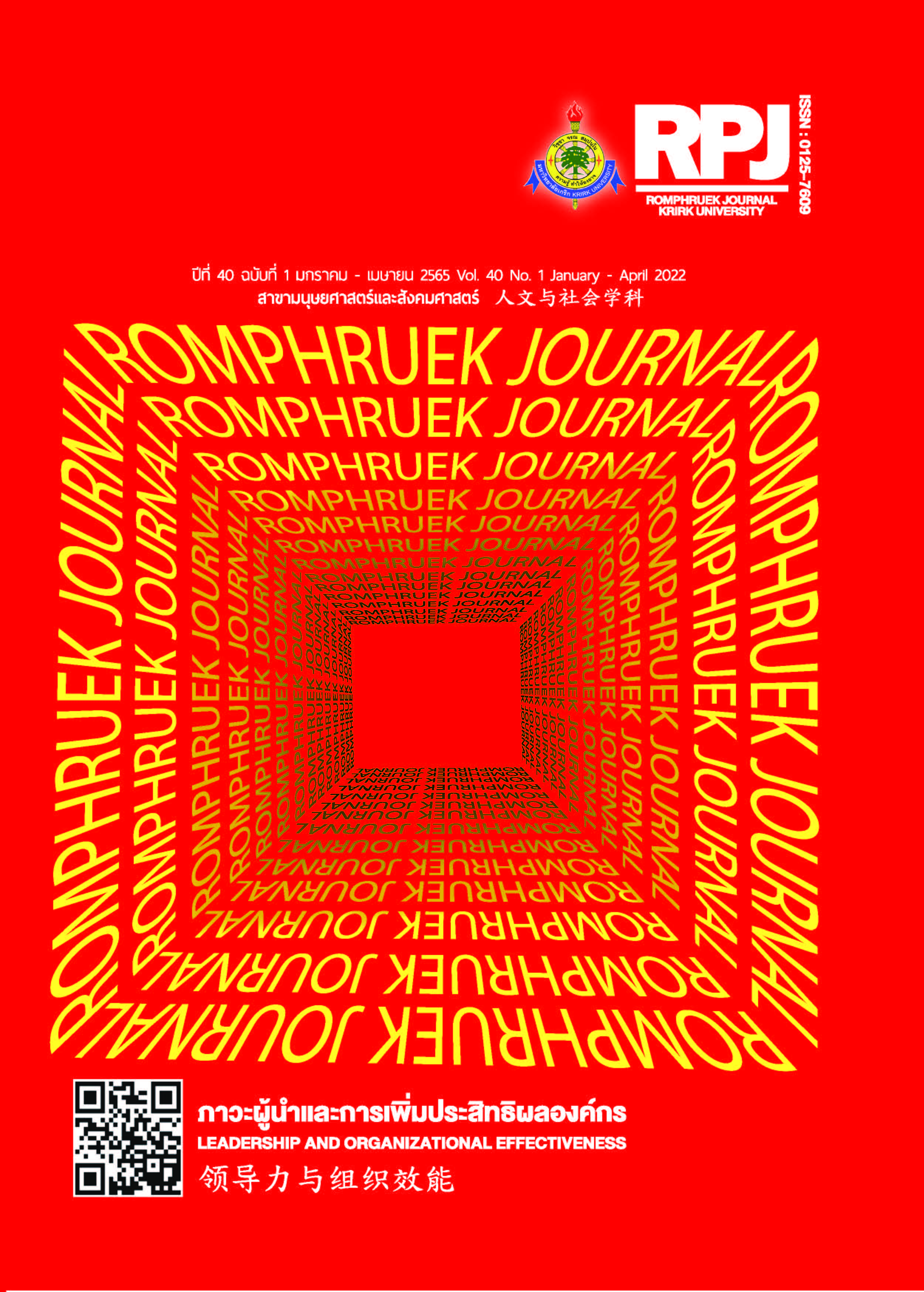Healthy Leadership : New Model of The 21st Century Leader
Main Article Content
Abstract
Healthy Leadership is a form of leadership in the 21st century to drive the organizational mechanisms through their personnel to work towards the goals of success and can respond to globalization. Particularly, the key attributes of a leader are: emotional intelligence; having a sense of humor; creating a secure and safe organizational atmosphere; building inspiration and motivation; developing knowledge, experience and ability to enhance the acceptable health system; having ability to think outside the box; being proactive and focusing on the results of the work; and ability to find methods, techniques or strategies to use in promoting, preventing and taking care of the health of personnel in order to prevent the epidemic from spreading further. In addition, healthy leadership should include these important components, namely, health promotion system development, safe and healthy environment of the organization arrangement, holistic health care of personnel, improving the quality of work life, effective communication, planning and monitoring health promotion, and teamwork.
Article Details

This work is licensed under a Creative Commons Attribution-NonCommercial-NoDerivatives 4.0 International License.
Every article published in the Romphruek Journal of the Humanities and Social Sciences is the opinion and point of view of the authors. Thery're not the viewpoint of Krirk University or the editored department. Any part or all of the articles for pablication must be clearly cited.
References
กัลยา วิริยะ. (2557). ภาวะผู้นำและการสร้างเสริมสุขภาพของนิสิตพยาบาลศาสตร์. วารสารมหาวิทยาลัยศรีนครินทรวิโรฒ (สาขาวิทยาศาสตร์และเทคโนโลยี), 5(9), 6-13.
ณัฏฐพันธ์ เขจรนันทน์. (2551). พฤติกรรมองค์การ. กรุงเทพฯ : บริษัท วี.พริ้นท์.
ทัศนา แสวงศักดิ์. (2556). ภาวะผู้นำในการบริหารงาน. กรุงเทพฯ : พี.เอ.ลีฟวิ่งจำกัด.
วิฑูรย์ สิมะโชคดี. (2550). การพัฒนาทรัพยากรมนุษย์. กรุงเทพฯ : เนตรนิมิตการพิมพ์.
สุพานี สฤษฎ์วานิช. (2552). พฤติกรรมองค์การสมัยใหม่ : แนวคิด และทฤษฎี. (พิมพ์ครั้งที่ 2).
ปทุมธานี : มหาวิทยาลัยธรรมศาสตร์.
ส่งเสริมสุรพล สาลิกา. (2558). ภาวะผู้นำของผู้อำนวยการโรงพยาบาลสุขภาพตำบลสังกัดสำนักงาน
สาธารณสุข จังหวัดอุบลราชธานี. วารสารสาธารณสุขศาสตร์ มหาวิทยาลัยขอนแก่น, 8(3), 21-
Akhtar, Miriam. (2015). Positive leadership : Positive Psychology. Training, 10 (5), 5-9.
Bekas S. (2014). Evaluating leadership development in postgraduate medical education.
Leadership Health Service, 27(1), 31–40.
Bennis, Warren, & Nanus, Burt. (1997). Leaders. New York : Happer Collins Publishers.
Bill , George (2021). Leadership in the 21st Century. (November 3, 2021) Retrieved from
www.billgeorge.org › articles › the-21st-century-leader.
Burke, R. J., & Cooper, C. L. (2004). Leading in Turbulent Times : Managing in the New World
of Work. Malden, Massachusetts : Blackwell Publishing.
Charan, R., Drotter, S., & Noel, J. (2001). The Leadership Pipeline : How to Build the
Leadership Powered Company. San Francisco : Jossey-Bass.
Christie, van Diggele. (2020). Leadership in healthcare education. (September 11, 2021)
Retrieved from https://www.ncbi.nlm.nih.gov/pmc/articles/PMC7712520/
Clark J. (2012). Medical leadership and engagement : no longer an optional extra.
Journal of Health Organizational Management, 26(4), 437–443.
Daft, Richard L. (2002). The Leadership Experience. Orlando : Hartcourt College Publishers.
De Casterle BD.; An, Willemse; Marc, Verschueren & Koen, Milisen. (2008). Impact of clinical
leadership development on the clinical leader, nursing team and care-giving process : a case study. Journal of Nurse Management, 16(6), 753–763.
DuBrin, A.J. (1998). Leadership : Research Finding, Practice and Skills. Boston : Houghton Muffling.
Edmonstone J. (2011). The development of strategic Healthy leaders in the National Health Service in Scotland. Journal of Leadership Health Service, 24(4), 337–353.
Ferguson L. (2007). Clinical leadership : using observations of care to focus risk management and quality improvement activities in the clinical setting. Journal of Contemporary Nurse, 24(2), 212–224.
Hersey, P., Blanchard, K. H. & Johnson, D. E. (1996). Management of Organization Behavior : Utilizing Human Resources. New Jersey : Prentice-Hall.
Howieson B, & Thaigarajah T. (2011). What is Healthy leadership? A journal-based meta-
review. Journal of Healthy leadership, 17(2), 7–18.
Jackson D. (2013). Understanding Avoidant Leadership in Health Care : Findings from
Secondary Analysis of two Qualitative Studies. Journal of Nurse Management. 1(3),572–580.
Kristin Burnham. (2020). Effective Leadership in Healthcare : 5 Essential Traits. Boston, USA. :
Northeastern University.
Lei Yao, Ping Li & Helen, Wildy. (2021). Health-Promoting Leadership : Concept, Measurement,
and Research Framework. (September 11, 2021) Retrieved from
https://www.frontiersin.org/articles/10.3389/fpsyg.2021.602333/full.
Locke, E. A. (1991). The Essence of Leadership : The Four Keys to Leading Successfully. New
York : Lexington Books.
Marcela, De Vivo. (2015). How to Be a Healthy Leader. (November 4, 2021) Retrieved from
marcelahealth.com›keytopics›healthy-leadership.
MacPhee M.; Chang,L. & Lee, D. (2013). Global Health Care Leadership Development :
Trends to Consider. Journal of Healthcare Leadership, 5(2), 21–29.
McKeon LM. ; Norris, Tl.; Webb, S.; Hix, C. (2009). Teaching Clinical Nurse Leaders How to
Diagnose the Clinical Microsystem. Professional Nurse, 25(6), 373–378.
Patrick A, (2011). Developing and Testing a New Measure of Staff Nurse Clinical
Leadership : the Clinical Leadership Survey. Nurse Managemant, 19(1), 449–460.
Reuben, Olugbenga, A.; Annette, Heather D. & Katharine, A Wallis. (2018). The Concept of
Leadership in the Health Care. Faculty of Nursing Aucklang University of Auckland,
New Zealand.
Ricky, Griffin, W. (2013). Basic Elements of Organizing. Texas : A & M University.
Rost, J. C. (1991). Leadership for the Twenty-First Century. New York : Praeger.
Siriwardena A. (2006). Releasing the Potential of Health Services : Translating Clinical
Leadership into Healthcare Quality Improvement. Quality Primary Care, 14(3), 125–128.
Stanley D. (2012). Clinical Leadership and Innovation. Journal of Nurse Education Practice,
(2), 119–126.
Yukl, Gary A. (2012). Leadership in Organization. New Jersey : Prentice–Hall.


